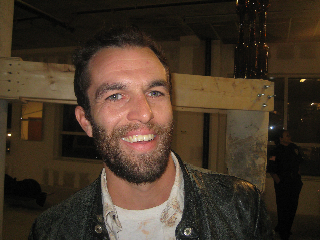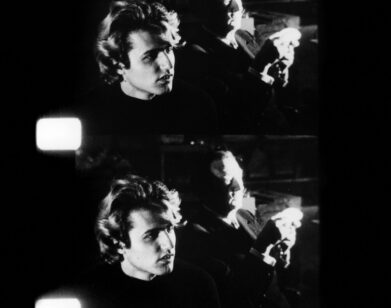Palm Reading

Nate Lowman; Naomi Campell. Photography by Linda Yablonsky
It was probably no coincidence that an unseasonable chill greeted the dealers and marketers arriving early this week for Art Basel Miami Beach. The economy had dipped below freezing, while collector/investors from the financial markets appear to be cooling their heels as well. Some people are calling this a death watch. What’s more, they appear to be enjoying it.
Dealers who stand to go bust at Miami Basel’s seventh edition might be relieved if they didn’t have to come back next year. At the Raleigh Hotel on Monday night, where Calvin Klein, Phillips auctioneer Simon de Pury and Herve Mikaeloff (private curator for LVMH’s Bernard Arnault) were among the conventioneers trickling in for dinner, I heard one dealer say, “It’s not so bad. The art market may actually return to sanity.” As if art should ever be reasonable. Where is the magic in that?
Peter Brant; artist Justin Lowe
Art fairs may have outlived their usefulness as art supermarkets where it’s possible to see everything going on in art today. Fairs inr ecent memory have been merchandise marts—salesrooms for the decorative and the shiny. The context is generally not so good for art that has something more to say than, “Hey, look at me!” What everyone would miss if fairs left the scene, however, is the social fabric that holds it together. Without it these fairs would not last a day. The price of art doesn’t have much meaning without the people who make it.
Festivities began on Tuesday night, to get the jump on the Miami Basel fair opening today. The New Museum held its annual benefit opening at the New Art Dealers Alliance fair in Wynwood and Vanity Fair International hosted the VIP preview of Anri Sala’s first U.S. museum retrospective at the Museum of Contemporary Art in North Miami. I never made it to either of those events, because I started at the Design Fair, situated in a commercial area across the causeway from South Beach where the Pulse, Bridge, Green, Art Miami, Photo Miami, Scope and Red Dot fairs have also pitched their tents. (All told, there are something like eighteen art fairs this season.)
All I can say for the Design Fair is that it has a much cleaner and better lit home than the Moore Building, its previous host, in a new temporary structure designed by the architects Aranda/Lasch. But most of the gimmicky, overscaled furniture I saw there seemed to have been made with airport lounges and corporate meeting rooms in mind. In a word, it was ugly. The Brazilian Campana Brothers were the darlings of the day, presumably because their chairs are made from recycled goods, like stuffed dolls. I saw a $2.8 million chandelier made with gold in channel settings, a stainless steel birdcage housing a miniature Wings of Samothrace, a stainless chair by Roderick Vos that looked like a bent tongue depressor—and, at Swarovski Crystal Palace, one spectacular “Liquid Space” chandelier, an inverted cone made with 250,000 crystals. I didn’t get the price.
From there I moved on to the Pulse Art Fair, where attendance by VIPs or anyone else was mighty sparse. Frankly, that made visiting the booths a rather genteel experience. Seldom do dealers at art fairs have time to speak at length about the work on view. It was oddly relaxing. I liked the Boo Ritson photos at New York’s BravinLee Programs and the Chris Hanlon paintings (Alan Rickman bought one) at London’s Domobaal, in the “Impulse” section dedicated to emerging art. “This year should be a thinking period,” said Domo Baal, who gave me a nifty illustrated chapbook by Ansel Krut. It was certainly quiet enough in there for reading.
Outside, the enterprising dealer Sara Meltzer had set herself up in an Airstream trailer outfitted by Design Within Reach with Eames and Knoll. From this mobile booth, she is hawking recession-priced charm bracelets by sculptor Jude Tallichet, who has created her own career retrospective by producing a repertoire of bronze, silver and gold miniatures (her shrink’s couch, a drum kit, a gasoline can, etc.) in limited editions. The trailer is for sale too, from Bates RV. (For catalogue, locations and hours this week, see www.sarameltzer.com.)
I stopped in at Bordello Bodega, a convenience store/social club that Miami artist Oliver Sanchez created in the front of his studio with vintage starlet photos, posters, paintings and snack foods (profits go to fund a local architecture and design school). A short hop away, I found Takashi Murakami nearly hidden within a rotund “Flowerball” suit—a plush toy, three-dimensional acrylic version of the openmouthed signature bloom with which he has festooned paintings, furniture and fabrics. He was performing at the opening of the KaiKai Kiki shop, which sells decorative objects from his studio. “This is my regular outfit now,” he said, laughing—he was barely able to stand in that getup. (He wasn’t kidding, though. Later that evening, he made Julian Schnabel and Calvin Klein scream when, still in that costume, he stepped off the elevator to the T Magazine party at the Raleigh Penthouse and waddled through the surprised crowd.)
Next door to KaiKai Kiki, the new Marni Miami shop opening was in full swing, under the watchful direction of fashion publicist Karla Otto. Marni’s pleasant designer Consuelo Castiglione swanned through the store, which she also designed, greeting all comers. I liked the sleeveless t-shirt she was wearing with her chunky necklace. (It has a cool Peter Blake illustration.) What I liked even better was a short, capelike goathair black jacket. Might have to go back.
After that, it seemed only fitting to check out the Naomi Campbell retrospective at the Fashion Photo Fair, located improbably enough beneath a blustery highway overpass. The fair, which was selling blowups of vintage photos from fashion magazines at absurd prices, was depressing, but it was kind of fun to see Campbell in some of her most classic supermodel guises. Remember when Paul Rowland dressed her up as Angela Davis in her Black Panther period? It’s still good. ($14,500.)
At that point, I really needed to see some real art. And it doesn’t get more real than the exhibition that Whitney curator Shamim Momin and artist Nate Lowman have organized in an unfinished mixed-use building called The Station, in what local realtors have named the Midtown Mall. Donated by Eleanor Cayre (a local collector), the two have installed new works by more than forty artists over three floors with 12,000 square feet of raw space. It’s fabulous—a 2009 version of the seminal 1980 Times Square Show organized by downtown artists in a former massage parlor scheduled for demolition.
This is one of the few times since that I’ve had such a good time at an art show. It’s what we all wish the Whitney Biennial would be, and never is. Sterling Ruby’s over-the-top Formica crypt, Rob Pruitt’s makeup mirror-like Anna Nicole Smith tombstone, and Rob Fischer’s hanging lamps on the first floor all looked great, but the best part was climbing through the walls of the Jonah Freeman/Justin Lowe multi-level installation of a hippie methedrine lab at the top of the building. It looked like a junkie’s tenement, all right, complete with sleeping dogs, peeling walls, mysterious specimen jars, a still, and a room filled with smoke. “It really gets at community psychosis,” explained Lowe (the actor Rob’s younger brother). What better metaphor for an art fair? “It’s great not to have to make sense,” said Lowman. Even better not to have to make money.
There was more. Much more. But it was time for Peter Brant’s super Art in America dinner at Joe’s Stone Crab—a normal art-world event, until the moment Naomi Campbell walked in with an entourage of bodyguards. The seas parted while she took a seat beside Stephanie Seymour. When I asked Campbell how she liked the retrospective, she went on a minor rant about the injustice that prevents supermodels from owning their own images. “It’s not about the money,” she said. “I gave my share of this to charity. It’s the principle.”
Principles at an art fair? That may be just what will keep such enterprises alive. After all, we can see art in a gallery or museum anytime. But without the out-of-body experience that such a concentration of personality, money and the unknowable provides, it really is not the same.






